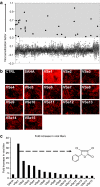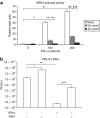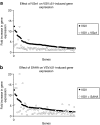A high-throughput pharmacoviral approach identifies novel oncolytic virus sensitizers
- PMID: 20389287
- PMCID: PMC2889739
- DOI: 10.1038/mt.2010.67
A high-throughput pharmacoviral approach identifies novel oncolytic virus sensitizers
Abstract
Oncolytic viruses (OVs) are promising anticancer agents but like other cancer monotherapies, the genetic heterogeneity of human malignancies can lead to treatment resistance. We used a virus/cell-based assay to screen diverse chemical libraries to identify small molecules that could act in synergy with OVs to destroy tumor cells that resist viral infection. Several molecules were identified that aid in viral oncolysis, enhancing virus replication and spread as much as 1,000-fold in tumor cells. One of these molecules we named virus-sensitizers 1 (VSe1), was found to target tumor innate immune response and could enhance OV efficacy in animal tumor models and within primary human tumor explants while remaining benign to normal tissues. We believe this is the first example of a virus/cell-based "pharmacoviral" screen aimed to identify small molecules that modulate cellular response to virus infection and enhance oncolytic virotherapy.
Figures





References
-
- Parato KA, Senger D, Forsyth PA., and , Bell JC. Recent progress in the battle between oncolytic viruses and tumours. Nat Rev Cancer. 2005;5:965–976. - PubMed
-
- Faria PA, Chakraborty P, Levay A, Barber GN, Ezelle HJ, Enninga J, et al. VSV disrupts the Rae1/mrnp41 mRNA nuclear export pathway. Mol Cell. 2005;17:93–102. - PubMed
-
- Stojdl DF, Lichty B, Knowles S, Marius R, Atkins H, Sonenberg N, et al. Exploiting tumor-specific defects in the interferon pathway with a previously unknown oncolytic virus. Nat Med. 2000;6:821–825. - PubMed
Publication types
MeSH terms
LinkOut - more resources
Full Text Sources
Other Literature Sources

